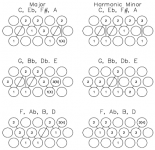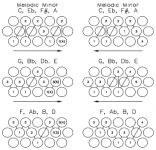great posts about the fingering conundrums. i have used the lars holm fingering suggestions but I think thinking outside the box as it were is useful as i have been mentally limited in options recently ref a previous post about the opening bar of" indifference "a real challenge. angazi uses much thumb for example while french players appear to avoid it like the plague. godgi
You are using an out of date browser. It may not display this or other websites correctly.
You should upgrade or use an alternative browser.
You should upgrade or use an alternative browser.
C-system fingering. Scales.
- Thread starter Chrisrayner
- Start date
- Status
- Not open for further replies.
bgilesuk
Member
If other members think it worthwhile, I can easily create diagrams, like in my previous post, showing the suggested fingering of scales as detailed in Lucien & Richard Galliano, Manu Maugain and Lars Holm (and other tutors).
Just mark up the templates below, I'll draw and title them, then post here.
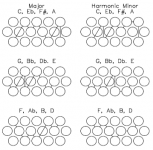
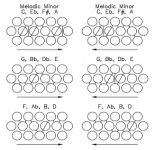
Brian
Just mark up the templates below, I'll draw and title them, then post here.


Brian
bgilesuk
Member
bgilesuk
Member
Hi Ben
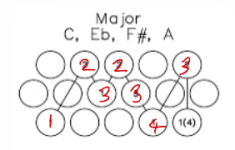
Interesting fingering you're using.
My first instrument has always been piano, so I chose C-griff in order to continue to use the thumb.
Your fingering rotates the hand so that its closer to a B-griff system, i.e. fingers pointing down towards the knees, rather than up towards the chin, which I assume is the more common positioning for C-griff.
Consequently, your fingering doesn't feel natural for me, as I'm so used to rotating the hand the other way.
Likewise, you're probably unable to comment on using fingers 4-5 at the top of the row 2 scales, for the same reason.
Thanks anyway
Brian

Interesting fingering you're using.
My first instrument has always been piano, so I chose C-griff in order to continue to use the thumb.
Your fingering rotates the hand so that its closer to a B-griff system, i.e. fingers pointing down towards the knees, rather than up towards the chin, which I assume is the more common positioning for C-griff.
Consequently, your fingering doesn't feel natural for me, as I'm so used to rotating the hand the other way.
Likewise, you're probably unable to comment on using fingers 4-5 at the top of the row 2 scales, for the same reason.
Thanks anyway
Brian
Last edited:
Im with Ben re this scale option.... But if its worth a note i like to 'rotate' the jand INTO the chord shape and then think about scale movements from there... Hope that makes sense and is helpful.... My choice of direction and rows re scale are dependant upon the next chord and so may xhange direction accordingly...
bgilesuk
Member
I can absolutely see the advantages of Ben's suggested fingering, having now tried that hand position again with all the major scales, just using the first 3 rows.
Whilst I'm not going to try and 'unlearn' the fingering I was taught, which matches that shown in Anzaghi, it would be very useful to learn alternative fingering, and document it for others users, hence my earlier offer.
I don't want to 'guess' what you and Ben are using for rows 2 and 3, and for that matter, melodic and harmonic minors, but if anybody provides logical alternatives (possibly a published tutor name), maybe collaborated by others players, I'm more than happy to draw them up and post them.
Brian
Whilst I'm not going to try and 'unlearn' the fingering I was taught, which matches that shown in Anzaghi, it would be very useful to learn alternative fingering, and document it for others users, hence my earlier offer.
I don't want to 'guess' what you and Ben are using for rows 2 and 3, and for that matter, melodic and harmonic minors, but if anybody provides logical alternatives (possibly a published tutor name), maybe collaborated by others players, I'm more than happy to draw them up and post them.
Brian
ChrisH
Member
I began playing C-griff back in November as a lockdown project. I started working through the Anzaghi scales, but then noticed that he used completely different fingerings in his tunes and exercises. I decided that scale fingerings are only really of use if you want to play scales; real music is a mix of scale and arpeggio fragments. So I just moved onto picking out familiar tunes, and found that the various phrases quickly became muscle-memory. After four months I'm pretty well matching my piano accordion playing speeds for a large part of my folk session/dance repertoire (albeit mainly in the keys of G & D)
The one important lesson I gleaned from Anzaghi was the importance of 'the tucking under of the thumb'.
Chris
I
The one important lesson I gleaned from Anzaghi was the importance of 'the tucking under of the thumb'.
Chris
I
Hi Brian,
Great to hear back from you - I think my fingering is pretty bog standard for playing music on a CBA. I have got a modern scale book that does fingering like yours but its pretty limited use when it comes to playing actual music. As Chris H and losthobos implies playing a musical phrase is different to an exercise for fingering
I'm (boringly) interested in fingering and coming from playing other keyboard instruments all my life to the CBA only 18 months ago I’ve followed avenues that are solid and lead to progress but also some others that are rabbit holes.
The only two points of fingering are to get music to the point when you always play the right notes (i.e. it can’t go wrong) and to achieve musical articulation of the notes. For this I’ve found this ‘system’ is the best for me:
Sorry to go on - its probably not the right forum for my geekiness about fingering!
Ben
Great to hear back from you - I think my fingering is pretty bog standard for playing music on a CBA. I have got a modern scale book that does fingering like yours but its pretty limited use when it comes to playing actual music. As Chris H and losthobos implies playing a musical phrase is different to an exercise for fingering
I'm (boringly) interested in fingering and coming from playing other keyboard instruments all my life to the CBA only 18 months ago I’ve followed avenues that are solid and lead to progress but also some others that are rabbit holes.
The only two points of fingering are to get music to the point when you always play the right notes (i.e. it can’t go wrong) and to achieve musical articulation of the notes. For this I’ve found this ‘system’ is the best for me:
- Fingers two three and four are your best friends and use as much as possible (very much like early music fingering on the organ or harpsichord); they also have the best independence so you can articulate each note exactly like you want. Finger 5 is weak but OK to get you out of a tight spot and thumb is handy for moving into a new hand position.
- If you play the same note twice in succession, always change the finger. This has two advantages: you get fresh articulation and you also have the chance to change hand positions if required for the next phrase.
- If you have a sequence (same short phrase but repeated at different pitches) always strive to use identical fingering irrespective of pitch. Hence the logic of the two repeater rows on a CBA.
Sorry to go on - its probably not the right forum for my geekiness about fingering!
Ben
bgilesuk
Member
Hi Chris & Ben
I've always considered scales and arpeggios to be the cornerstones of learning music, as they are encountered so often.
CBA accordions are blessed with the option of using a variation on fingering, or using the duplicate rows, to get to your destination.
I therefore concluded that the more variations you have committed to memory for fingering, the more likely you are to quickly recall the appropriate one when learning a piece, rather than having to stop and work it out.
Maybe I'm just over analysing it, and ultimately it makes very little difference, but nevertheless, I wanted to experiment by learning scales with alternate fingering, hence joining this topic.
As Ben points out, fingering when playing a piano if far more restricted and inflexible, so scales tend to only follow one convention on fingering.
Ben:
Thanks for the tips, which I do generally follow, but will try using the thumb less, to see if that helps with articulation.
What would be most helpful is if you could confirm the fingers you use for the major scales starting on rows 2 and 3 (e.g. G and F) and restricted to rows 1-3.
I believe I've worked them out, but wanted them checked. I've included the ones for row 1 you've mentioned in an earlier post.
R1: 1 2 3 2 3 4 3(2) 4
R2: 3 4 2 4 2 3 4 3
R3: 2 3 4 3 4 2 3 2
Assuming I got the above right, I can work out the minors accordingly.
Many thanks both.
Brian
I've always considered scales and arpeggios to be the cornerstones of learning music, as they are encountered so often.
CBA accordions are blessed with the option of using a variation on fingering, or using the duplicate rows, to get to your destination.
I therefore concluded that the more variations you have committed to memory for fingering, the more likely you are to quickly recall the appropriate one when learning a piece, rather than having to stop and work it out.
Maybe I'm just over analysing it, and ultimately it makes very little difference, but nevertheless, I wanted to experiment by learning scales with alternate fingering, hence joining this topic.
As Ben points out, fingering when playing a piano if far more restricted and inflexible, so scales tend to only follow one convention on fingering.
Ben:
Thanks for the tips, which I do generally follow, but will try using the thumb less, to see if that helps with articulation.
What would be most helpful is if you could confirm the fingers you use for the major scales starting on rows 2 and 3 (e.g. G and F) and restricted to rows 1-3.
I believe I've worked them out, but wanted them checked. I've included the ones for row 1 you've mentioned in an earlier post.
R1: 1 2 3 2 3 4 3(2) 4
R2: 3 4 2 4 2 3 4 3
R3: 2 3 4 3 4 2 3 2
Assuming I got the above right, I can work out the minors accordingly.
Many thanks both.
Brian
I am assuming that this fingering doesn't use the thumb and numbers the index finger as 1?Hi folks
I did the following charts for my accordion teacher some years ago, to hand out to his pupils.
The Major and Melodic Minor are in the 1990 'Anzaghi' accordion tutor, but the Harmonic Minor I've extrapolated.
The fingers in brackets are those suggested in the book when you reach the top of the scale.
The Major and Melodic Minor ones starting in row 2 (i.e. G, Bb, Dd, E), suggest finishing with fingers 4 and 5, moving from row 1 to 2.
I find this most uncomfortable, so I use 1-4, and was wondering if anyone comfortably uses 4-5 at the top?
Brian
Most modern systems now use all five digits.
Edited, forget the above as, reading on, the thumb is mentioned, just no one (apart from me) seems to use it
Last edited:
@Pipemajor and me.... ? Thumbs up... ??
Hi Brian,
The principles I put down above get you where is most musically useful for consistent CBA fingering and articulation rather than scale books. Believe me it works as I've only been playing 18 months but have made fast progress because I never attempted to do scales over three rows exclusively. The piano needs scale practice because the keyboard is inconsistent; the 5 row CBA keyboard is consistent. I've never tried playing a three row CBA but attempting to do everything on three rows is bound to be more complicated than 5 so I haven't seen the point in going there as it negates all the simplicity of the CBA keyboard.
You could say there is only one basic fingering for 5 row CBA to cover all keys in major and (ascending melodic) minors. Your root note at the start and at the end is either on 1 or 4 depending on what has preceded or where you need to go next in the music.
An ascending melodic minor is the same as the major, just starts on 6th degree of major scale, so it doesn't need any different fingering. Of course you will start it on 1 rather than 4 if the root is the first note of the musical pattern you are about to play.
Hope that makes sense - I'm sort of saying thinking from the scale book is a rabbit hole on a CBA in my opinion and better to think in principles I posted above and let your fingers do the walking in the most natural way........
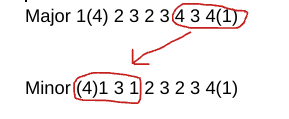
The principles I put down above get you where is most musically useful for consistent CBA fingering and articulation rather than scale books. Believe me it works as I've only been playing 18 months but have made fast progress because I never attempted to do scales over three rows exclusively. The piano needs scale practice because the keyboard is inconsistent; the 5 row CBA keyboard is consistent. I've never tried playing a three row CBA but attempting to do everything on three rows is bound to be more complicated than 5 so I haven't seen the point in going there as it negates all the simplicity of the CBA keyboard.
You could say there is only one basic fingering for 5 row CBA to cover all keys in major and (ascending melodic) minors. Your root note at the start and at the end is either on 1 or 4 depending on what has preceded or where you need to go next in the music.
An ascending melodic minor is the same as the major, just starts on 6th degree of major scale, so it doesn't need any different fingering. Of course you will start it on 1 rather than 4 if the root is the first note of the musical pattern you are about to play.
Hope that makes sense - I'm sort of saying thinking from the scale book is a rabbit hole on a CBA in my opinion and better to think in principles I posted above and let your fingers do the walking in the most natural way........

bgilesuk
Member
Hi Ben
Maybe I am heading down a rabbit hole with this one, and my ultimate objective is pointless, as in reality, like you say, if we're fortunate to have 5 rows at our disposal, so long as we can start on an appropriate finger, we can use the same fingering all the time.
However, I remember my CBA teacher from all those years ago, who was also a performer, initially restricting me to using the first 3 rows, so I could use the fingering learnt in the scales. It was only later that he permitted me to utilise the additional rows to establish if there was an easier path to take.
Furthermore, not everyone on this forum may be fortunate enough to have 5 rows to their disposal, and for them, alternative fingering my be beneficial.
I've enjoyed learning scales using your fingering, as it rotates the hand in the opposite direction (down) to the fingering I've been using, potentially giving me another option when learning a new piece, but if I was to embark on documenting fingering for 4 or 5 rows, it would never be completed, as there are so many permutations.
I consider melodic minor different to you, where only the 3rd is diminished going up, with the addition of the 6th and 7th being diminished coming down. This is also how they are shown in the Anzaghi tutor.
It not clear to me if the your major scale fingering is restricted to 3 rows, as the penultimate note (i.e. 7th), which is in row 3, is shown as played by your 3rd finger, whereas the other row 3 notes (i.e. 2nd and 4th) are played by your 2nd finger, which would be my logical choice also for the 7th?

For my own reference, I've drawn up all the scales using the 2 methods (i.e. primary fingers 1-3, and 2-4), which utilise the hand rotated in the both directions, and included snippets below. But in view of what you're said, I'm not sure if I should take it any further in this topic if it's going to confuse matters.
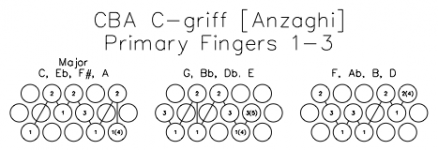
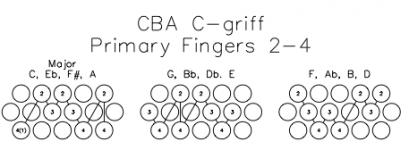
Thanks
Brian
Maybe I am heading down a rabbit hole with this one, and my ultimate objective is pointless, as in reality, like you say, if we're fortunate to have 5 rows at our disposal, so long as we can start on an appropriate finger, we can use the same fingering all the time.
However, I remember my CBA teacher from all those years ago, who was also a performer, initially restricting me to using the first 3 rows, so I could use the fingering learnt in the scales. It was only later that he permitted me to utilise the additional rows to establish if there was an easier path to take.
Furthermore, not everyone on this forum may be fortunate enough to have 5 rows to their disposal, and for them, alternative fingering my be beneficial.
I've enjoyed learning scales using your fingering, as it rotates the hand in the opposite direction (down) to the fingering I've been using, potentially giving me another option when learning a new piece, but if I was to embark on documenting fingering for 4 or 5 rows, it would never be completed, as there are so many permutations.
I consider melodic minor different to you, where only the 3rd is diminished going up, with the addition of the 6th and 7th being diminished coming down. This is also how they are shown in the Anzaghi tutor.
It not clear to me if the your major scale fingering is restricted to 3 rows, as the penultimate note (i.e. 7th), which is in row 3, is shown as played by your 3rd finger, whereas the other row 3 notes (i.e. 2nd and 4th) are played by your 2nd finger, which would be my logical choice also for the 7th?
For my own reference, I've drawn up all the scales using the 2 methods (i.e. primary fingers 1-3, and 2-4), which utilise the hand rotated in the both directions, and included snippets below. But in view of what you're said, I'm not sure if I should take it any further in this topic if it's going to confuse matters.


Thanks
Brian
Last edited:
Hi Brian,
Interesting discussion as it made me write down how I get around the CBA keyboard which I 'knew' but hadn't ever explained until I was forced to write it down! I was terrified of it at first being a life long pianist/organist however I now see how much more simple it is. I guess it depends how your brain is wired...mine looks for consistent principles rather than rules so if i'm working something out it is on the basis of the principles I outlined above rather than a zillion different scales. I'll PM you an extremely modern scale book which will help you play scales but in my humble opinion is next to useless for learning fingering for real music.
Cheers, Ben
Interesting discussion as it made me write down how I get around the CBA keyboard which I 'knew' but hadn't ever explained until I was forced to write it down! I was terrified of it at first being a life long pianist/organist however I now see how much more simple it is. I guess it depends how your brain is wired...mine looks for consistent principles rather than rules so if i'm working something out it is on the basis of the principles I outlined above rather than a zillion different scales. I'll PM you an extremely modern scale book which will help you play scales but in my humble opinion is next to useless for learning fingering for real music.
Cheers, Ben
For what its worth last night i tryed to transpose 2 fairly big tunes (ie not just 3 chord tricks and ibtend to play right hand voicings too...) into the Keys of C, G and F... So starting on a different row each time...
Was more difficult than id imagined as often when moving to the 4 (sub dominant) my brain and fingers wanted to change to that key and chord family if id played the whole tune in that key normally...
An exercise i wish id payed more attention to in the past....
This learning is endless.... ?
Was more difficult than id imagined as often when moving to the 4 (sub dominant) my brain and fingers wanted to change to that key and chord family if id played the whole tune in that key normally...
An exercise i wish id payed more attention to in the past....
This learning is endless.... ?
ChrisH
Member
Ben wrote "Finger 5 is weak but OK to get you out of a tight spot and thumb is handy for moving into a new hand position."
When I read this I generally agreed re the use of the 5th finger. But I started thinking about it being weak, and concluded that this is probably a legacy from playing the weighted action on a piano... the keys and buttons on accordions require very little pressure.
I spent an hour on the CBA this morning making a conscious effort to use the little finger and found that after a short while it started to become the natural choice for the upper notes of many of the phrases in the music. This really improves fluency by freeing up the remaining fingers. I'm definitely going to keep working on this... maybe even trying to use the 5th a bit more on the left hand!
Chris
When I read this I generally agreed re the use of the 5th finger. But I started thinking about it being weak, and concluded that this is probably a legacy from playing the weighted action on a piano... the keys and buttons on accordions require very little pressure.
I spent an hour on the CBA this morning making a conscious effort to use the little finger and found that after a short while it started to become the natural choice for the upper notes of many of the phrases in the music. This really improves fluency by freeing up the remaining fingers. I'm definitely going to keep working on this... maybe even trying to use the 5th a bit more on the left hand!
Chris
This is all very interesting and a bit confusing. My question is this, For someone starting out in CBA with a 5 row C griff accordion, doesn't it make most sense to start playing on all 5 rows right away? And if so, does someone have a diagram of the fingering for the 1 pattern that works in all scales?
Unfortunately @Tom it's not that simple... Or could actually become a handicap if you try to make it so...
Best advice I'd give is concentrate on your chord shapes, learn them as arpeggios, and learn as inversions... Start with 3 note chords and progress to 4, 5 note chords.
Stick within one family to start to see the connections... Ie C, Dmin, Emin, F, G7, Amin, B half dim....
This will pay off a damn site quicker that rattling through scales....
Once you've nailed the chords start playi g as a arpeggios but adding a note (say tje 9th D) so pattern CDEG, or FGAC etc. Or add the 6th...EGAC, ACDF... etc
This is gonna sound a more like music than do ray blah de blah...
Good luck
Best advice I'd give is concentrate on your chord shapes, learn them as arpeggios, and learn as inversions... Start with 3 note chords and progress to 4, 5 note chords.
Stick within one family to start to see the connections... Ie C, Dmin, Emin, F, G7, Amin, B half dim....
This will pay off a damn site quicker that rattling through scales....
Once you've nailed the chords start playi g as a arpeggios but adding a note (say tje 9th D) so pattern CDEG, or FGAC etc. Or add the 6th...EGAC, ACDF... etc
This is gonna sound a more like music than do ray blah de blah...
Good luck
Hi Tom,
My view is yes, use all five rows straight away if you want to play scales and more importantly understand how to walk over the keyboard with good articulation for music making.
I posted diagram in 31 march above.
Cheers Ben
My view is yes, use all five rows straight away if you want to play scales and more importantly understand how to walk over the keyboard with good articulation for music making.
I posted diagram in 31 march above.
Cheers Ben
Since some have voted the other way I'll throw in a vote for sticking to three rows to start with.
- Fewer buttons, fewer alternatives, it's easier to get the patterns well established in your head.
- Just three fingering patterns give you all the keys. (I think of them as the C, D and G patterns.)
- It means you can stop looking down at the keyboard sooner. I'd actually suggest a cardboard "shield" tucked into the bellows strap at the top as a reminder not to look down. You won't need it for long.
- It pushes you into using fingering that will be valuable in the long term, rather than taking the easy option of going to another row.
- Although in the real world it's not as easy as the theory suggests, it keeps open the option of transposing to any other key by shifting rows.
- In the longer term it keeps your options open for playing three or four row instruments.
- It makes reading music onto CBA easier. You quickly learn which notes are in which row, and you have just one place for that note.
- Fewer buttons, fewer alternatives, it's easier to get the patterns well established in your head.
- Just three fingering patterns give you all the keys. (I think of them as the C, D and G patterns.)
- It means you can stop looking down at the keyboard sooner. I'd actually suggest a cardboard "shield" tucked into the bellows strap at the top as a reminder not to look down. You won't need it for long.
- It pushes you into using fingering that will be valuable in the long term, rather than taking the easy option of going to another row.
- Although in the real world it's not as easy as the theory suggests, it keeps open the option of transposing to any other key by shifting rows.
- In the longer term it keeps your options open for playing three or four row instruments.
- It makes reading music onto CBA easier. You quickly learn which notes are in which row, and you have just one place for that note.
- Status
- Not open for further replies.
Similar threads
- Replies
- 16
- Views
- 3,206
- Replies
- 7
- Views
- 500
- Replies
- 11
- Views
- 4,416
- Replies
- 9
- Views
- 2,843

